PRINCETON, NJ -- More than two-thirds of Americans (69%) are closely following news accounts of town hall meetings on healthcare reform, and while 34% say the protests make them more sympathetic to the protestors' viewpoints and 21% say the protests make them less sympathetic, almost half either say the protests haven't affected their views either way or have no opinion.
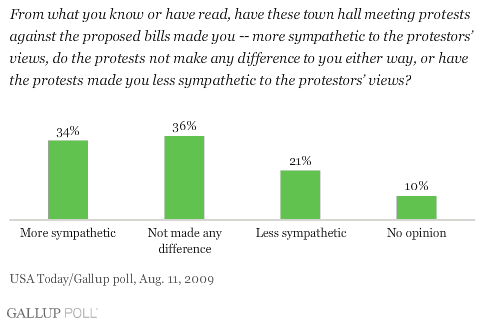
Video clips of angry protestors speaking up at various town hall meetings held by members of Congress and senators on proposed healthcare reform legislation across the country have dominated news coverage of healthcare reform in recent days.
A new USA Today/ÆéûÜǨû§poll conducted Tuesday night shows that Americans have quite mixed reactions to the protests. For the most part, these reactions vary along traditional partisan lines -- as has been the case for much of the healthcare reform debate to date.
1. Americans, particularly Republicans, are paying close attention to the town hall protests.
Almost 7 out of 10 Americans (69%) say they are very or somewhat closely following the news about the protests taking place at town hall healthcare meetings.
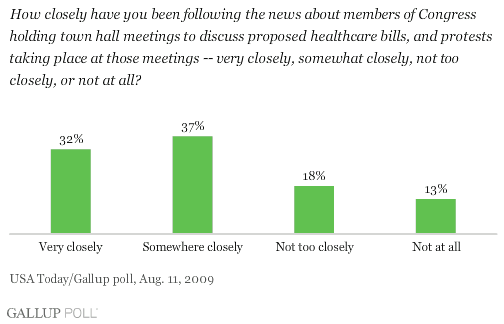
Republicans are paying a modestly higher amount of attention to the news of the protests than are independents or Democrats.
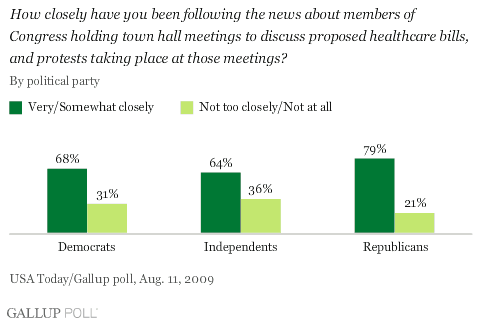
2. Americans tilt toward saying the protests make them more sympathetic to the protestors' views rather than saying the protests make them less sympathetic. A sizable number of Americans have no opinion or say the protests haven't affected them.
Over a third of Americans (36%) say the protests have made no difference in their sympathy toward the protestors' viewpoints. Another 10% say they have no opinion on the impact of the protests. That adds up to almost half who report not being affected in either direction. Thirty-four percent say the protests have made them more sympathetic to the protestors' views, compared to 21% who say the protests have made them less sympathetic.
3. Those paying the most attention to the protests are the most likely to say the protests have made them sympathetic to the protestors' views.
This is not a surprising finding, given that Republicans are the partisan group most likely to be paying attention to the protests. The overall relationship between paying attention and being more sympathetic may thus reflect two factors: a) those sympathetic to the protestors may choose to pay the most attention, or b) those who pay attention have become more sympathetic in the process of watching the protests unfold.
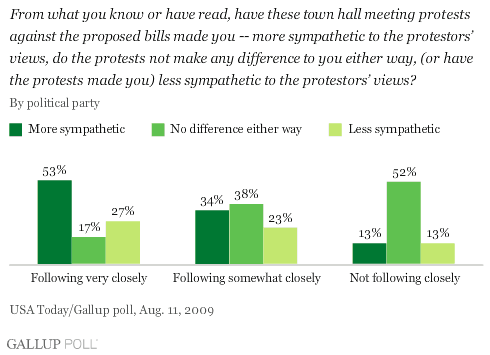
4. Reaction to the protests is highly partisan. A little more than half of Republicans say the protests have made them more sympathetic to the protestors' views. About 4 out of 10 Democrats, on the other hand, say the protests have made them less sympathetic.
These results suggest that the backlash against the protestors among Americans is not so severe as to outweigh an increase in sympathy for the protestors' views. This appears to be driven mainly by the fact that Democrats don't report a lessening of sympathy for the protestors' views as much as Republicans report gaining sympathy -- coupled with the fact that more independents report gaining sympathy than losing it. Republicans split 51% more sympathetic to 8% less sympathetic, while Democrats are 17% more sympathetic to 39% less. Independents resemble the Republican pattern more than the Democratic one.
It should be noted that the survey questions did not identify the protestors as representing any particular party, although the wording did stipulate "town hall meeting protests against the proposed bills." This wording is presumably a cue to respondents that the protestors are speaking out against the healthcare proposals that President Obama and other Democrats have put forth.
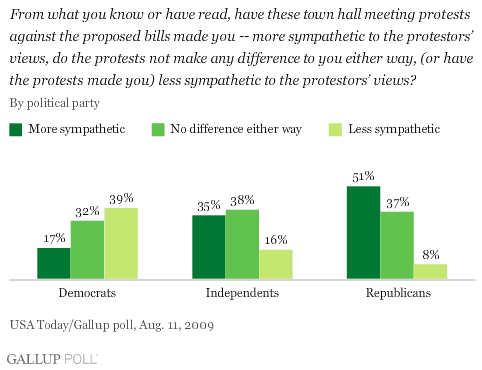
5. Americans, particularly Republicans, are more likely to say the protests reflect the pre-existing views of the protestors, rather than reflecting recent efforts by political activists to create organized opposition.
Each respondent was given -- in random order -- two explanations for why the protests against the healthcare bills are taking place at these town hall meetings.
One explanation assumed an internal motivation -- namely, that the protests are manifestations of pre-existing attitudes of the citizens who are protesting. The other explanation was more external -- that the protests reflect the efforts of political activists who are attempting to create organized opposition to new healthcare bills. There is not much difference in views of the importance of each of these explanations, but Americans are somewhat more likely to say that pre-existing attitudes are a cause of the protests than to say the protests reflect activists' efforts.

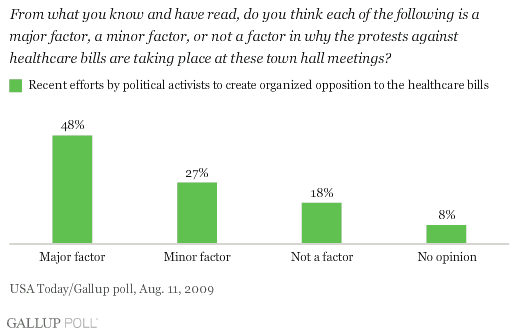
There are the expected differences across party lines in the attributions of the causes behind the protests.
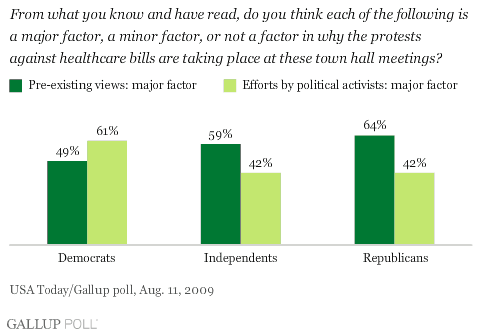
6. Americans are more likely to say angry attacks against a healthcare bill are "democracy in action" rather than an "abuse of democracy." Booing members of Congress and shouting down opponents are more likely to be seen as abuses of democracy.
Americans have differing views of the appropriateness of the behaviors that can be exhibited by protestors at town hall meetings. The poll asked Americans to indicate whether three such behaviors are examples of democracy in action, or examples of an abuse of democracy. The percentage of Americans perceiving that the behaviors are abuses ranges from 41% for making angry attacks against a healthcare bill to 59% for shouting down supporters when they speak in favor of a healthcare bill.
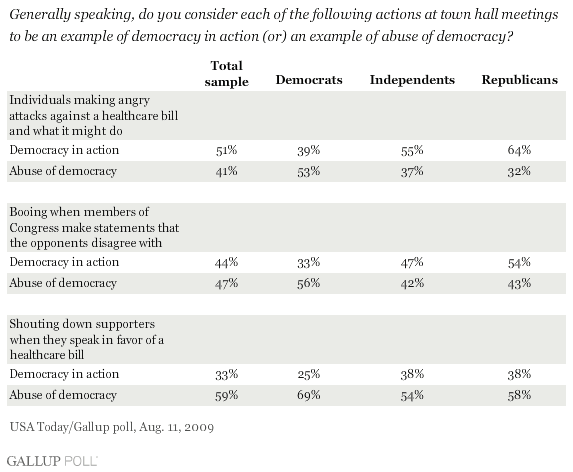
There is a fair degree of consensus among Democrats, independents, and Republicans about the "shouting down" behavior as described in the survey. A clear majority of each partisan group says this represents an abuse of democracy.
Opinions are more divided on the other two behaviors. For both the "angry attacks" and "booing" behaviors, a majority of Democrats say they are abuses, while a majority of Republicans say they are democracy in action. In both instances, independents are more likely to side with the Republican than with the Democratic position.
Survey Methods
Results are based on telephone interviews with 1,000 national adults, aged 18 and older, conducted Aug. 11, 2009, as part of ÆéûÜǨû§Poll Daily tracking. For results based on the total sample of national adults, one can say with 95% confidence that the maximum margin of sampling error is ôÝ4 percentage points.
Interviews are conducted with respondents on land-line telephones (for respondents with a land-line telephone) and cellular phones (for respondents who are cell-phone only).
In addition to sampling error, question wording and practical difficulties in conducting surveys can introduce error or bias into the findings of public opinion polls.
Polls conducted entirely in one day, such as this one, are subject to additional error or bias not found in polls conducted over several days.
